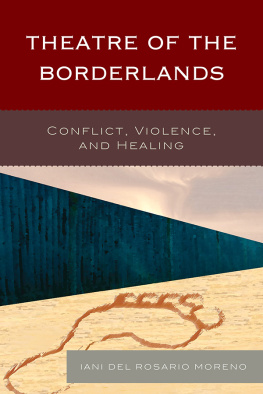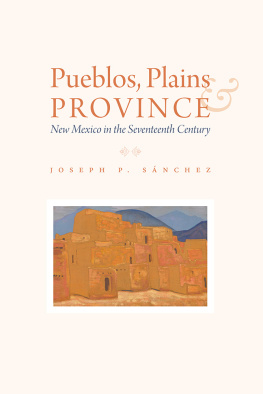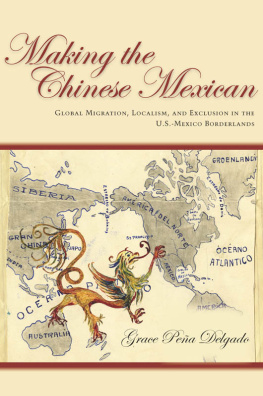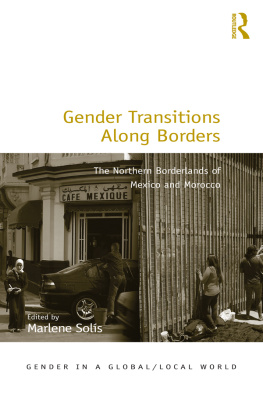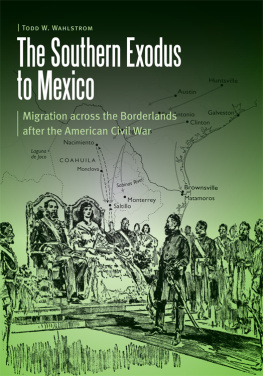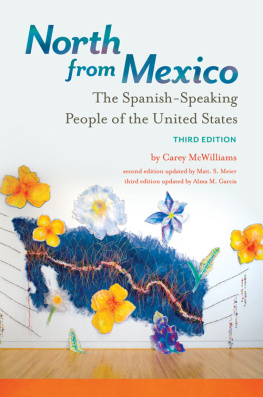EXPERIENCES IN THE
HISTORICAL BORDERLANDS
A Shared Ancestry
Dolores M. Martnez
Copyright 2018 by Dolores M. Martnez.
Library of Congress Control Number: 2018907945
ISBN: Hardcover 978-1-9845-3987-8
Softcover 978-1-9845-3986-1
eBook 978-1-9845-3988-5
All rights reserved. No part of this book may be reproduced or transmitted in any form or by any means, electronic or mechanical, including photocopying, recording, or by any information storage and retrieval system, without permission in writing from the copyright owner.
Any people depicted in stock imagery provided by Getty Images are models, and such images are being used for illustrative purposes only.
Certain stock imagery Getty Images.
Rev. date: 07/09/2018
Xlibris
1-888-795-4274
www.Xlibris.com
769179
CONTENTS
LIST OF FIGURES
LIST OF TABLES
DEDICATION
This book is dedicated to my beloved mother Maria Petronila Montoya de Gonzales, affectionately known as Patsy Montoya, and the adventure she gave me in seeking the past; and to my beloved son Kristian Anthony Martnez who will forever be in my heart, may there be Justice one day.
ACKNOWLEDGEMENT
S PECIAL THANKS TO, Dr. Bob Clifton and Dr. Kathryn Cheever, for their guidance through my graduate studies. They made a huge impact on my life and I will be forever grateful for having known them.
I wish to thank Anna Sampaio for her valuable insight and direction; Tom Noel Dr. Colorado who provided me with the incentive to follow the historical direction of my work; and special thanks to Jana Everett for her support and guidance. This thesis was extremely valuable to me and to the descendants of the early inhabitants of the southwest region of the United States, the early settlers of the Sangre de Cristo Mountains.
I would especially like to thank my husband Jos Pedro for his support and encouragement while I worked on this most interesting project. Special thanks to my mother Patsy and my father John who were great storytellers, may they live on through these words that you will be reading.
CHAPTER 1
Introduction
C URIOSITY AND RESEARCH can bring out many interesting discoveries in life. The experience in northern New Mexico and southern Colorado is too encompassing to be a short story of events. This is a story of fascinating lives of many interesting people who lived long ago. Although they may seem but a string of names on a page to some, they are more. As a society, these ancestors left a legacy that is unforgettable. Through my discoveries, the obligation to share the valuable history of the past with others is great, not only for my family but for my extended family, whoever they may be. Whoever finds their path in this work, please continue it for me, as this history is the legacy we leave to our descendents. If we fail to record experiences, our past dies with us.
To understand the complex issues that we face in todays global society, we need to look back into the past to see where we have been to direct a better future for our children and grandchildren. We cannot ignore history nor fail to record the valuable facts of a peoples existence that we believe are missing in the historical archives today. To ignore the suffering, alienation, hardships, famines, death and genocide that the Spanish colonizers and indigenous populations faced is to disregard the historical facts that make us who we are today.
Many scholars, writers, and genealogists recorded events surrounding the religion, culture, and politics of the inhabitants of northern New Mexico and southern Colorado prior to statehood in the United States of America. The exploration of the world was at an all time high. It should be remembered that the discovery of America revolutionized the common geographical ideas of the time. It required several generations, moreover, before the shape and size of North America were definitely known (Hammond, 1938, p. 33). Regarding history of the southwest, most of the historical documentation is derived from translations of the Spanish archives, which show a one-sided view of history in the southwest region. Many of the historical documents that did exist in this region were lost during various conflicts and battles. The indigenous people passed down history through the ages through oral tradition. However, many important historical facts were hidden as a means of their survival; these facts remain secret to this day. Other historical documentation of this time period came from researchers, who meticulously searched records, interviewed, and explored to find the answer the questions that still puzzle us today. Many early writers and historians were very instrumental in documenting the history of northern New Mexico and southern Colorado for future generations, and this project will contribute to that research.
In my experience in researching the early Hispanos and indigenous native population, I discovered history books do not truly depict them, but we tend to believe what we read. In fact, a large segment of the Hispano history of 1500s to 1900s is missing this distinct population in society. During this time, life was hard enough due to natural physical hardships; but with it came colonization, which brought Spanish oppression of the indigenous populations. Despite the sufferings and tribulations this population went through, the descendants of the Spanish and indigenous populations were self-sufficient farmers and agriculturists, responsible for their own welfare, and able to defend their own communities. They practiced their religion, and when they did not have religious leaders, they relied on their own lay religion.
Many Hispano community leaders were very interested in government and contributed to the growth of the State of Colorado. Facts indicate that prior to Colorado becoming a state many Spanish-surnamed people were active in the various councils and legislative bodies, which led to the establishment of the Colorado Territory and finally to Statehood (Vigil, 1976, p. 184). The Spanish population was very interested in being part of the new government. In the Legislative Assembly of January 3, 1876, there were 12 Spanish-surnamed legislators (Vigil, 1976, p. 184-185).
Note, this is only 28 years after the signing of the Treaty of Guadalupe Hidalgo, which ended what was at that time the bloodiest and costliest war in American history (Gutierrez, 1995, p. 13). The change in sovereignty over Mexicos former Northern provinces deeply affected the lives of the nearly 100,000 ethnic Mexicans who had become American citizens under the terms of the Treaty of Guadalupe Hidalgo (Gutierrez, 1995, p.20). Additionally, the first state Constitution was written in English, Spanish, and German (State of Colorado, 2007). It appears that the legislators at that time recognized their multicultural constituency. Despite this enthusiastic start to becoming United States citizens, we will see the fabric of this society reaching depths of poverty.
The historical experiences in northern New Mexico and southern Colorado are much greater than can be explored in this project. The term Hispano will be used to identify the Latino population in the southwest during the 1500s to 1900s. Hispanos have been identified as a distinct population in New Mexico and southern Colorado by economics, religion, politics, education, language, and heritage. There were changes in population size and demographics for over 400 years. The culture also changed over time, and now the identities of the descendents of the Spanish colonists and Pueblo and Plains Indian tribes are questioned. Who are these people? In this global society they are about to lose the little that is left of their historical identity.
Many atrocities happened in the region but that did not prevent the blending and mixing of this population. Colonized for centuries by the Spanish empire, briefly ruled by the Mexican government, and then purchased by the United States of America, this Hispano population has combined into one people that predate all but the indigenous populations, of which they are a part.
Next page


